Research Methods in Organizational Change: A Comprehensive Report
VerifiedAdded on 2020/03/13
|13
|4293
|578
Report
AI Summary
This report provides a comprehensive overview of the research methodology employed to study organizational change. It begins with an introduction to the research philosophy, emphasizing pragmatism and its use of both quantitative and qualitative data analysis. The report then delves into the research approach, specifically the deductive approach, and outlines the research strategies used, including case studies and surveys. The case study strategy is described in detail, highlighting its benefits and limitations, while the survey method is presented as a means of gathering practical data. The research design section discusses qualitative and quantitative philosophies, explaining their roles and limitations in the context of the study. Data sources and collection methods are also thoroughly examined, including the use of questionnaires, observation, structured, semi-structured, and unstructured interviews, as well as focus groups. The report emphasizes the importance of various data collection instruments and their significance in gathering primary data, providing a detailed insight into the research process and its underlying principles. The document is contributed by a student to Desklib, a platform offering AI-powered study tools for students.
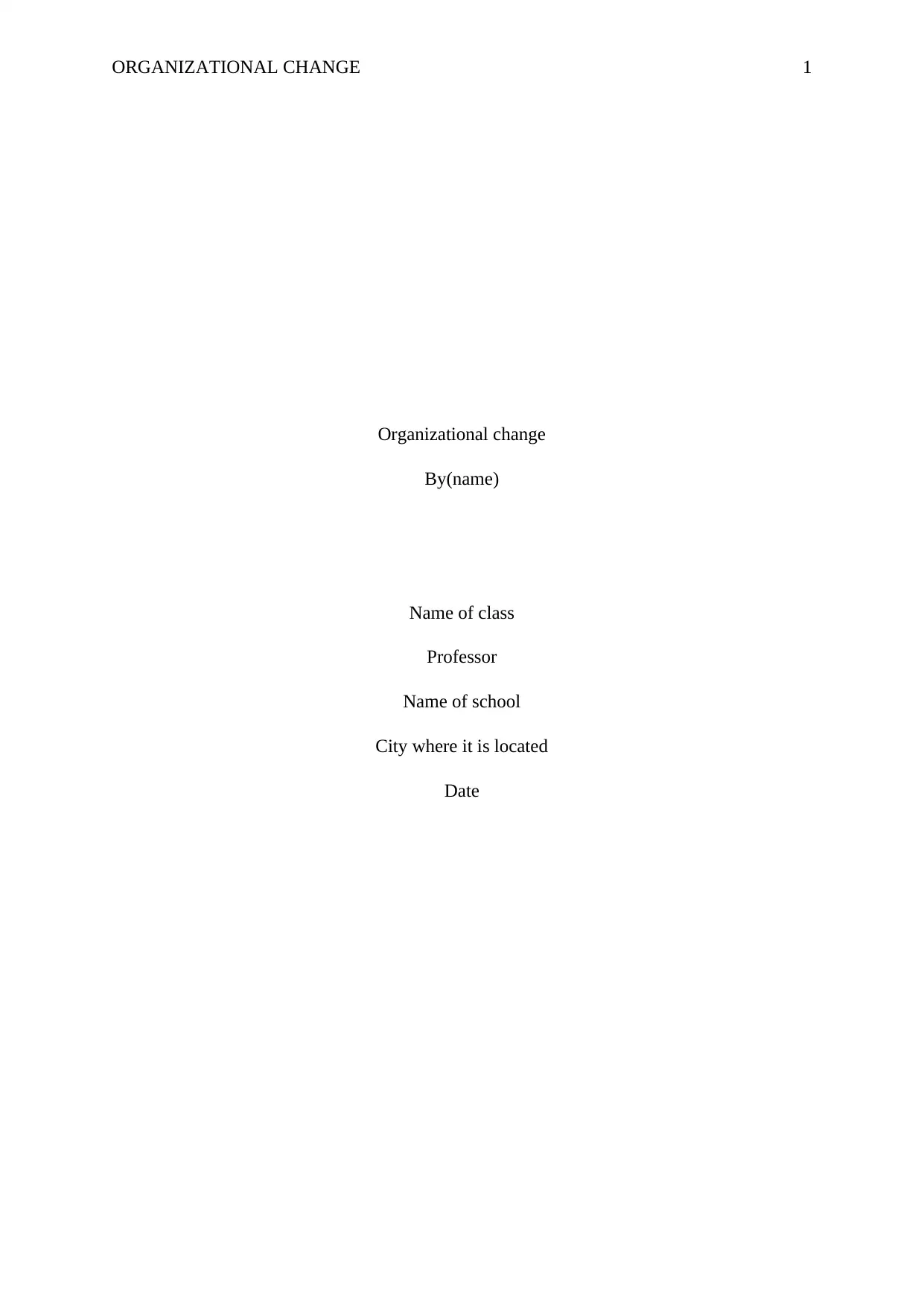
ORGANIZATIONAL CHANGE 1
Organizational change
By(name)
Name of class
Professor
Name of school
City where it is located
Date
Organizational change
By(name)
Name of class
Professor
Name of school
City where it is located
Date
Paraphrase This Document
Need a fresh take? Get an instant paraphrase of this document with our AI Paraphraser
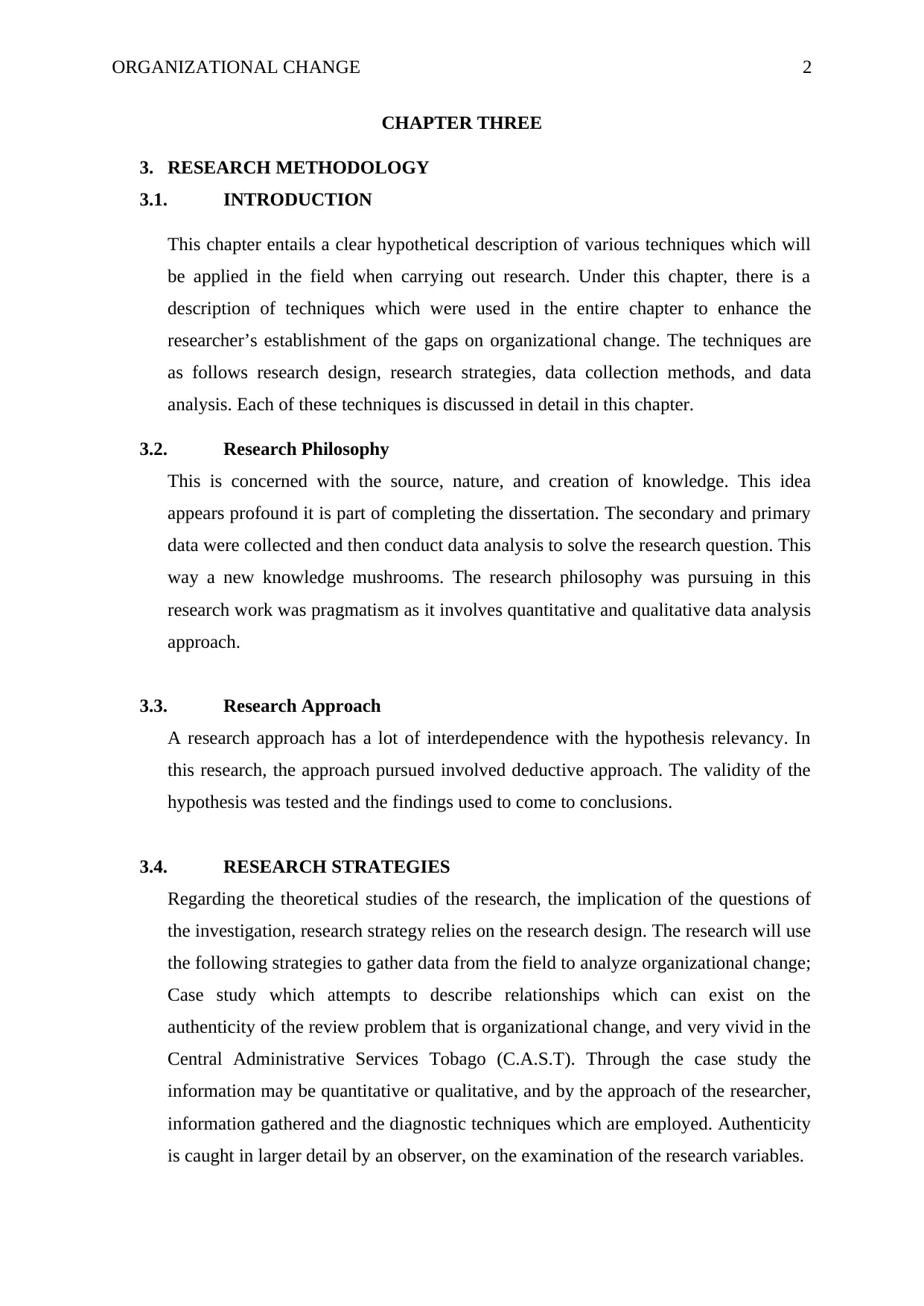
ORGANIZATIONAL CHANGE 2
CHAPTER THREE
3. RESEARCH METHODOLOGY
3.1. INTRODUCTION
This chapter entails a clear hypothetical description of various techniques which will
be applied in the field when carrying out research. Under this chapter, there is a
description of techniques which were used in the entire chapter to enhance the
researcher’s establishment of the gaps on organizational change. The techniques are
as follows research design, research strategies, data collection methods, and data
analysis. Each of these techniques is discussed in detail in this chapter.
3.2. Research Philosophy
This is concerned with the source, nature, and creation of knowledge. This idea
appears profound it is part of completing the dissertation. The secondary and primary
data were collected and then conduct data analysis to solve the research question. This
way a new knowledge mushrooms. The research philosophy was pursuing in this
research work was pragmatism as it involves quantitative and qualitative data analysis
approach.
3.3. Research Approach
A research approach has a lot of interdependence with the hypothesis relevancy. In
this research, the approach pursued involved deductive approach. The validity of the
hypothesis was tested and the findings used to come to conclusions.
3.4. RESEARCH STRATEGIES
Regarding the theoretical studies of the research, the implication of the questions of
the investigation, research strategy relies on the research design. The research will use
the following strategies to gather data from the field to analyze organizational change;
Case study which attempts to describe relationships which can exist on the
authenticity of the review problem that is organizational change, and very vivid in the
Central Administrative Services Tobago (C.A.S.T). Through the case study the
information may be quantitative or qualitative, and by the approach of the researcher,
information gathered and the diagnostic techniques which are employed. Authenticity
is caught in larger detail by an observer, on the examination of the research variables.
CHAPTER THREE
3. RESEARCH METHODOLOGY
3.1. INTRODUCTION
This chapter entails a clear hypothetical description of various techniques which will
be applied in the field when carrying out research. Under this chapter, there is a
description of techniques which were used in the entire chapter to enhance the
researcher’s establishment of the gaps on organizational change. The techniques are
as follows research design, research strategies, data collection methods, and data
analysis. Each of these techniques is discussed in detail in this chapter.
3.2. Research Philosophy
This is concerned with the source, nature, and creation of knowledge. This idea
appears profound it is part of completing the dissertation. The secondary and primary
data were collected and then conduct data analysis to solve the research question. This
way a new knowledge mushrooms. The research philosophy was pursuing in this
research work was pragmatism as it involves quantitative and qualitative data analysis
approach.
3.3. Research Approach
A research approach has a lot of interdependence with the hypothesis relevancy. In
this research, the approach pursued involved deductive approach. The validity of the
hypothesis was tested and the findings used to come to conclusions.
3.4. RESEARCH STRATEGIES
Regarding the theoretical studies of the research, the implication of the questions of
the investigation, research strategy relies on the research design. The research will use
the following strategies to gather data from the field to analyze organizational change;
Case study which attempts to describe relationships which can exist on the
authenticity of the review problem that is organizational change, and very vivid in the
Central Administrative Services Tobago (C.A.S.T). Through the case study the
information may be quantitative or qualitative, and by the approach of the researcher,
information gathered and the diagnostic techniques which are employed. Authenticity
is caught in larger detail by an observer, on the examination of the research variables.

ORGANIZATIONAL CHANGE 3
Case studies enhance holistic review hence clear understanding since the researcher
uses a wide range of tools for the research. Through this, there is the creation of space
and a lot of time to establish clear understanding on the topic and to establish factors
influencing the study. On the other hand, the case studies reduce the incidence of
biases. The limitations of case studies are the restriction they are given hence difficult
to generate the findings or data gathered as related case studies are with similar data
that can be used during analysis are not available. Also, different research may have
different interpretations. They have wider relevance since the data cannot be
generalized since they are wide and they are time-consuming to study. The
interpretations must be made with an open mind. Looking at the research from
different dimensions help in identifying all the possible interpretation of the results of
the study. (Fedor, Caldwell and Herold, 2006.).
Secondly, the researcher will use a survey to gather information in the field that is
data of practical, situations or views in each point through questionnaires and
interviews. The quantitative technique can be used to in drawing inferences from the
information gathered depending on the possible relationship to the study. The survey
has a significance since it allows the study to be carried out intensively. Intensive
study is useful since it ensures that the conclusions made at the end of the study
portray the truth and has minimal biases. It is not to make conclusions that are half-
baked only because of the methods used to collect data. This, therefore, leads to the
observation that surveys should be used to collect data. However, to have the best
results, it is to use multiple methods to collect data from the field. The use of surveys,
questionnaires, observations and secondary methods of collecting data would,
therefore, yield the best result for most study. The methods used should, however, be
directly applicable to the study. For instance, it would be advisable to use methods
such as observations in an experimental laboratory setting. However, when the study
involves people, questionnaires must be incorporated to reinforce the information
collected through the testing. The results from the questionnaires would be useful in
eliminating various assumption. The report obtained from the experiment done would,
however, confirm the expectation is giving a clear view of the discussion and
eliminating biases.
3.5. RESEARCH DESIGN
Case studies enhance holistic review hence clear understanding since the researcher
uses a wide range of tools for the research. Through this, there is the creation of space
and a lot of time to establish clear understanding on the topic and to establish factors
influencing the study. On the other hand, the case studies reduce the incidence of
biases. The limitations of case studies are the restriction they are given hence difficult
to generate the findings or data gathered as related case studies are with similar data
that can be used during analysis are not available. Also, different research may have
different interpretations. They have wider relevance since the data cannot be
generalized since they are wide and they are time-consuming to study. The
interpretations must be made with an open mind. Looking at the research from
different dimensions help in identifying all the possible interpretation of the results of
the study. (Fedor, Caldwell and Herold, 2006.).
Secondly, the researcher will use a survey to gather information in the field that is
data of practical, situations or views in each point through questionnaires and
interviews. The quantitative technique can be used to in drawing inferences from the
information gathered depending on the possible relationship to the study. The survey
has a significance since it allows the study to be carried out intensively. Intensive
study is useful since it ensures that the conclusions made at the end of the study
portray the truth and has minimal biases. It is not to make conclusions that are half-
baked only because of the methods used to collect data. This, therefore, leads to the
observation that surveys should be used to collect data. However, to have the best
results, it is to use multiple methods to collect data from the field. The use of surveys,
questionnaires, observations and secondary methods of collecting data would,
therefore, yield the best result for most study. The methods used should, however, be
directly applicable to the study. For instance, it would be advisable to use methods
such as observations in an experimental laboratory setting. However, when the study
involves people, questionnaires must be incorporated to reinforce the information
collected through the testing. The results from the questionnaires would be useful in
eliminating various assumption. The report obtained from the experiment done would,
however, confirm the expectation is giving a clear view of the discussion and
eliminating biases.
3.5. RESEARCH DESIGN
⊘ This is a preview!⊘
Do you want full access?
Subscribe today to unlock all pages.

Trusted by 1+ million students worldwide
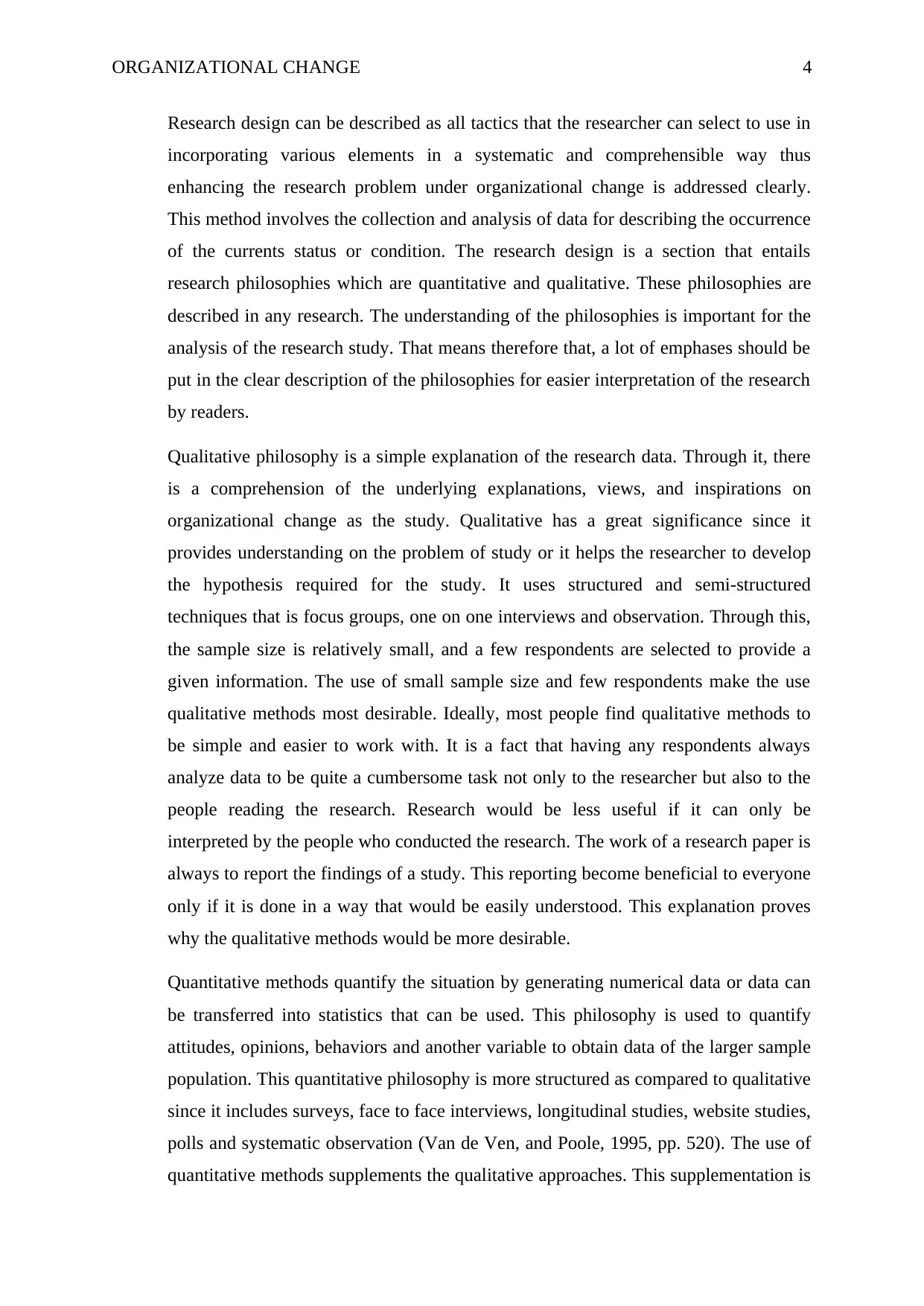
ORGANIZATIONAL CHANGE 4
Research design can be described as all tactics that the researcher can select to use in
incorporating various elements in a systematic and comprehensible way thus
enhancing the research problem under organizational change is addressed clearly.
This method involves the collection and analysis of data for describing the occurrence
of the currents status or condition. The research design is a section that entails
research philosophies which are quantitative and qualitative. These philosophies are
described in any research. The understanding of the philosophies is important for the
analysis of the research study. That means therefore that, a lot of emphases should be
put in the clear description of the philosophies for easier interpretation of the research
by readers.
Qualitative philosophy is a simple explanation of the research data. Through it, there
is a comprehension of the underlying explanations, views, and inspirations on
organizational change as the study. Qualitative has a great significance since it
provides understanding on the problem of study or it helps the researcher to develop
the hypothesis required for the study. It uses structured and semi-structured
techniques that is focus groups, one on one interviews and observation. Through this,
the sample size is relatively small, and a few respondents are selected to provide a
given information. The use of small sample size and few respondents make the use
qualitative methods most desirable. Ideally, most people find qualitative methods to
be simple and easier to work with. It is a fact that having any respondents always
analyze data to be quite a cumbersome task not only to the researcher but also to the
people reading the research. Research would be less useful if it can only be
interpreted by the people who conducted the research. The work of a research paper is
always to report the findings of a study. This reporting become beneficial to everyone
only if it is done in a way that would be easily understood. This explanation proves
why the qualitative methods would be more desirable.
Quantitative methods quantify the situation by generating numerical data or data can
be transferred into statistics that can be used. This philosophy is used to quantify
attitudes, opinions, behaviors and another variable to obtain data of the larger sample
population. This quantitative philosophy is more structured as compared to qualitative
since it includes surveys, face to face interviews, longitudinal studies, website studies,
polls and systematic observation (Van de Ven, and Poole, 1995, pp. 520). The use of
quantitative methods supplements the qualitative approaches. This supplementation is
Research design can be described as all tactics that the researcher can select to use in
incorporating various elements in a systematic and comprehensible way thus
enhancing the research problem under organizational change is addressed clearly.
This method involves the collection and analysis of data for describing the occurrence
of the currents status or condition. The research design is a section that entails
research philosophies which are quantitative and qualitative. These philosophies are
described in any research. The understanding of the philosophies is important for the
analysis of the research study. That means therefore that, a lot of emphases should be
put in the clear description of the philosophies for easier interpretation of the research
by readers.
Qualitative philosophy is a simple explanation of the research data. Through it, there
is a comprehension of the underlying explanations, views, and inspirations on
organizational change as the study. Qualitative has a great significance since it
provides understanding on the problem of study or it helps the researcher to develop
the hypothesis required for the study. It uses structured and semi-structured
techniques that is focus groups, one on one interviews and observation. Through this,
the sample size is relatively small, and a few respondents are selected to provide a
given information. The use of small sample size and few respondents make the use
qualitative methods most desirable. Ideally, most people find qualitative methods to
be simple and easier to work with. It is a fact that having any respondents always
analyze data to be quite a cumbersome task not only to the researcher but also to the
people reading the research. Research would be less useful if it can only be
interpreted by the people who conducted the research. The work of a research paper is
always to report the findings of a study. This reporting become beneficial to everyone
only if it is done in a way that would be easily understood. This explanation proves
why the qualitative methods would be more desirable.
Quantitative methods quantify the situation by generating numerical data or data can
be transferred into statistics that can be used. This philosophy is used to quantify
attitudes, opinions, behaviors and another variable to obtain data of the larger sample
population. This quantitative philosophy is more structured as compared to qualitative
since it includes surveys, face to face interviews, longitudinal studies, website studies,
polls and systematic observation (Van de Ven, and Poole, 1995, pp. 520). The use of
quantitative methods supplements the qualitative approaches. This supplementation is
Paraphrase This Document
Need a fresh take? Get an instant paraphrase of this document with our AI Paraphraser
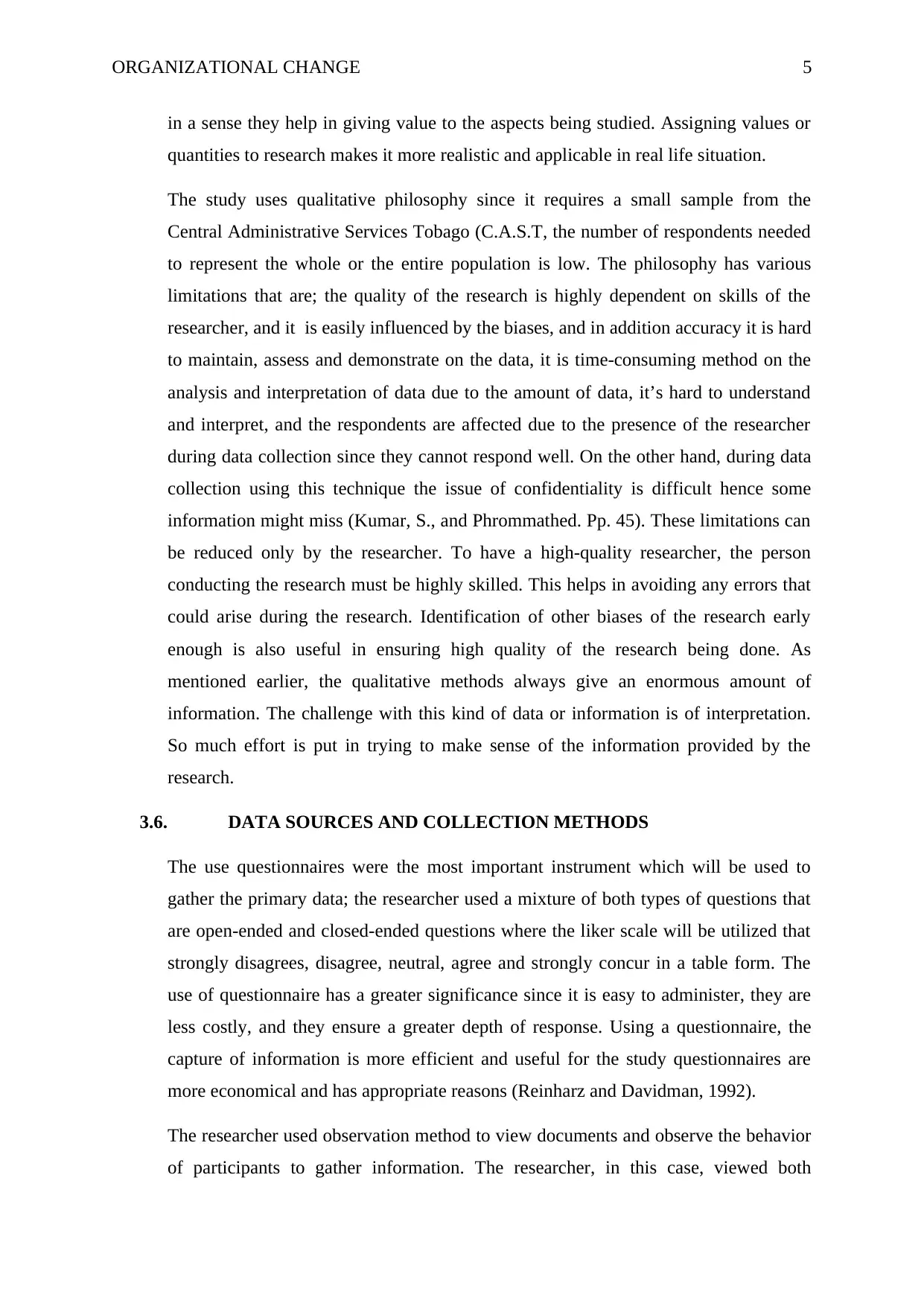
ORGANIZATIONAL CHANGE 5
in a sense they help in giving value to the aspects being studied. Assigning values or
quantities to research makes it more realistic and applicable in real life situation.
The study uses qualitative philosophy since it requires a small sample from the
Central Administrative Services Tobago (C.A.S.T, the number of respondents needed
to represent the whole or the entire population is low. The philosophy has various
limitations that are; the quality of the research is highly dependent on skills of the
researcher, and it is easily influenced by the biases, and in addition accuracy it is hard
to maintain, assess and demonstrate on the data, it is time-consuming method on the
analysis and interpretation of data due to the amount of data, it’s hard to understand
and interpret, and the respondents are affected due to the presence of the researcher
during data collection since they cannot respond well. On the other hand, during data
collection using this technique the issue of confidentiality is difficult hence some
information might miss (Kumar, S., and Phrommathed. Pp. 45). These limitations can
be reduced only by the researcher. To have a high-quality researcher, the person
conducting the research must be highly skilled. This helps in avoiding any errors that
could arise during the research. Identification of other biases of the research early
enough is also useful in ensuring high quality of the research being done. As
mentioned earlier, the qualitative methods always give an enormous amount of
information. The challenge with this kind of data or information is of interpretation.
So much effort is put in trying to make sense of the information provided by the
research.
3.6. DATA SOURCES AND COLLECTION METHODS
The use questionnaires were the most important instrument which will be used to
gather the primary data; the researcher used a mixture of both types of questions that
are open-ended and closed-ended questions where the liker scale will be utilized that
strongly disagrees, disagree, neutral, agree and strongly concur in a table form. The
use of questionnaire has a greater significance since it is easy to administer, they are
less costly, and they ensure a greater depth of response. Using a questionnaire, the
capture of information is more efficient and useful for the study questionnaires are
more economical and has appropriate reasons (Reinharz and Davidman, 1992).
The researcher used observation method to view documents and observe the behavior
of participants to gather information. The researcher, in this case, viewed both
in a sense they help in giving value to the aspects being studied. Assigning values or
quantities to research makes it more realistic and applicable in real life situation.
The study uses qualitative philosophy since it requires a small sample from the
Central Administrative Services Tobago (C.A.S.T, the number of respondents needed
to represent the whole or the entire population is low. The philosophy has various
limitations that are; the quality of the research is highly dependent on skills of the
researcher, and it is easily influenced by the biases, and in addition accuracy it is hard
to maintain, assess and demonstrate on the data, it is time-consuming method on the
analysis and interpretation of data due to the amount of data, it’s hard to understand
and interpret, and the respondents are affected due to the presence of the researcher
during data collection since they cannot respond well. On the other hand, during data
collection using this technique the issue of confidentiality is difficult hence some
information might miss (Kumar, S., and Phrommathed. Pp. 45). These limitations can
be reduced only by the researcher. To have a high-quality researcher, the person
conducting the research must be highly skilled. This helps in avoiding any errors that
could arise during the research. Identification of other biases of the research early
enough is also useful in ensuring high quality of the research being done. As
mentioned earlier, the qualitative methods always give an enormous amount of
information. The challenge with this kind of data or information is of interpretation.
So much effort is put in trying to make sense of the information provided by the
research.
3.6. DATA SOURCES AND COLLECTION METHODS
The use questionnaires were the most important instrument which will be used to
gather the primary data; the researcher used a mixture of both types of questions that
are open-ended and closed-ended questions where the liker scale will be utilized that
strongly disagrees, disagree, neutral, agree and strongly concur in a table form. The
use of questionnaire has a greater significance since it is easy to administer, they are
less costly, and they ensure a greater depth of response. Using a questionnaire, the
capture of information is more efficient and useful for the study questionnaires are
more economical and has appropriate reasons (Reinharz and Davidman, 1992).
The researcher used observation method to view documents and observe the behavior
of participants to gather information. The researcher, in this case, viewed both
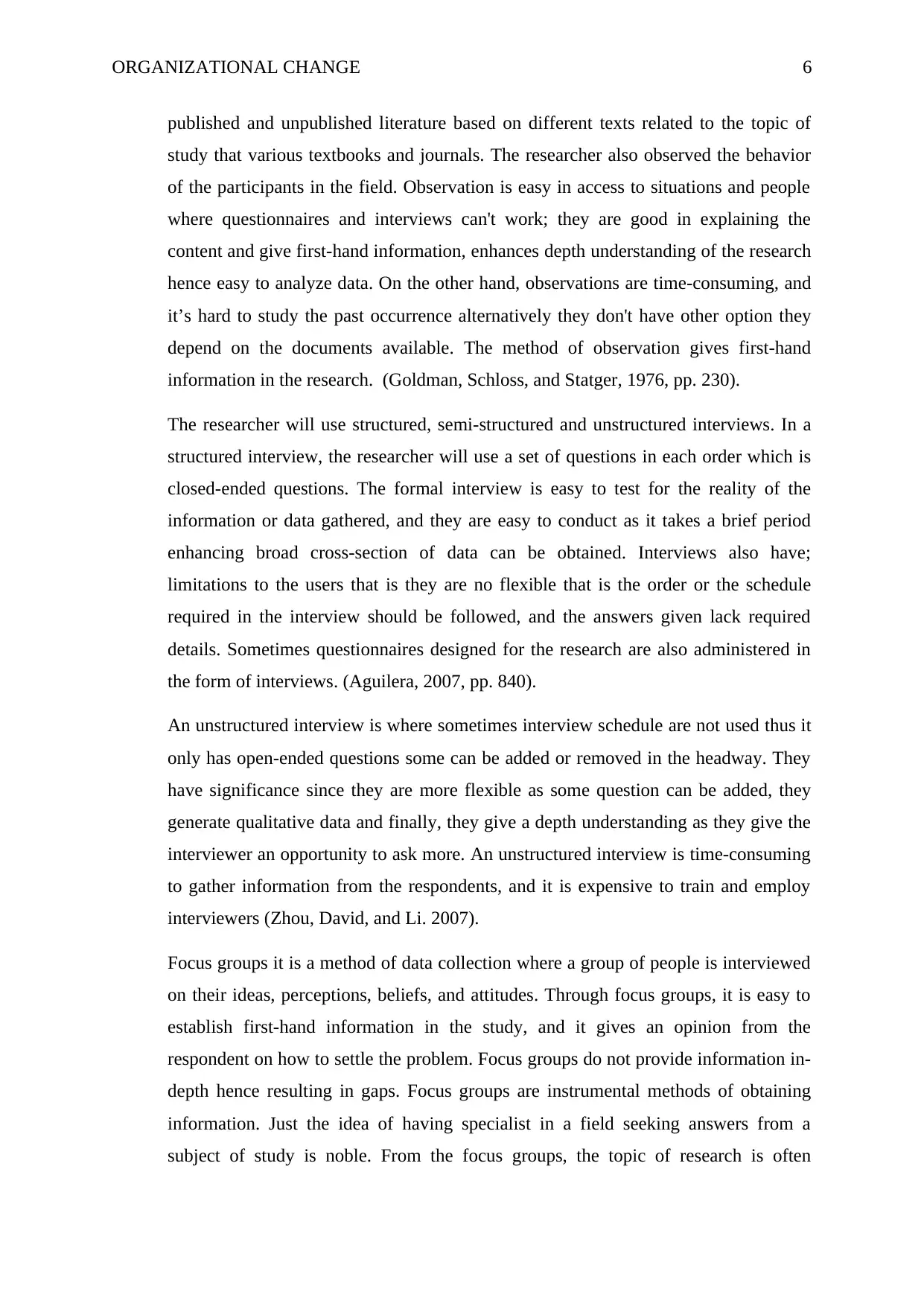
ORGANIZATIONAL CHANGE 6
published and unpublished literature based on different texts related to the topic of
study that various textbooks and journals. The researcher also observed the behavior
of the participants in the field. Observation is easy in access to situations and people
where questionnaires and interviews can't work; they are good in explaining the
content and give first-hand information, enhances depth understanding of the research
hence easy to analyze data. On the other hand, observations are time-consuming, and
it’s hard to study the past occurrence alternatively they don't have other option they
depend on the documents available. The method of observation gives first-hand
information in the research. (Goldman, Schloss, and Statger, 1976, pp. 230).
The researcher will use structured, semi-structured and unstructured interviews. In a
structured interview, the researcher will use a set of questions in each order which is
closed-ended questions. The formal interview is easy to test for the reality of the
information or data gathered, and they are easy to conduct as it takes a brief period
enhancing broad cross-section of data can be obtained. Interviews also have;
limitations to the users that is they are no flexible that is the order or the schedule
required in the interview should be followed, and the answers given lack required
details. Sometimes questionnaires designed for the research are also administered in
the form of interviews. (Aguilera, 2007, pp. 840).
An unstructured interview is where sometimes interview schedule are not used thus it
only has open-ended questions some can be added or removed in the headway. They
have significance since they are more flexible as some question can be added, they
generate qualitative data and finally, they give a depth understanding as they give the
interviewer an opportunity to ask more. An unstructured interview is time-consuming
to gather information from the respondents, and it is expensive to train and employ
interviewers (Zhou, David, and Li. 2007).
Focus groups it is a method of data collection where a group of people is interviewed
on their ideas, perceptions, beliefs, and attitudes. Through focus groups, it is easy to
establish first-hand information in the study, and it gives an opinion from the
respondent on how to settle the problem. Focus groups do not provide information in-
depth hence resulting in gaps. Focus groups are instrumental methods of obtaining
information. Just the idea of having specialist in a field seeking answers from a
subject of study is noble. From the focus groups, the topic of research is often
published and unpublished literature based on different texts related to the topic of
study that various textbooks and journals. The researcher also observed the behavior
of the participants in the field. Observation is easy in access to situations and people
where questionnaires and interviews can't work; they are good in explaining the
content and give first-hand information, enhances depth understanding of the research
hence easy to analyze data. On the other hand, observations are time-consuming, and
it’s hard to study the past occurrence alternatively they don't have other option they
depend on the documents available. The method of observation gives first-hand
information in the research. (Goldman, Schloss, and Statger, 1976, pp. 230).
The researcher will use structured, semi-structured and unstructured interviews. In a
structured interview, the researcher will use a set of questions in each order which is
closed-ended questions. The formal interview is easy to test for the reality of the
information or data gathered, and they are easy to conduct as it takes a brief period
enhancing broad cross-section of data can be obtained. Interviews also have;
limitations to the users that is they are no flexible that is the order or the schedule
required in the interview should be followed, and the answers given lack required
details. Sometimes questionnaires designed for the research are also administered in
the form of interviews. (Aguilera, 2007, pp. 840).
An unstructured interview is where sometimes interview schedule are not used thus it
only has open-ended questions some can be added or removed in the headway. They
have significance since they are more flexible as some question can be added, they
generate qualitative data and finally, they give a depth understanding as they give the
interviewer an opportunity to ask more. An unstructured interview is time-consuming
to gather information from the respondents, and it is expensive to train and employ
interviewers (Zhou, David, and Li. 2007).
Focus groups it is a method of data collection where a group of people is interviewed
on their ideas, perceptions, beliefs, and attitudes. Through focus groups, it is easy to
establish first-hand information in the study, and it gives an opinion from the
respondent on how to settle the problem. Focus groups do not provide information in-
depth hence resulting in gaps. Focus groups are instrumental methods of obtaining
information. Just the idea of having specialist in a field seeking answers from a
subject of study is noble. From the focus groups, the topic of research is often
⊘ This is a preview!⊘
Do you want full access?
Subscribe today to unlock all pages.

Trusted by 1+ million students worldwide
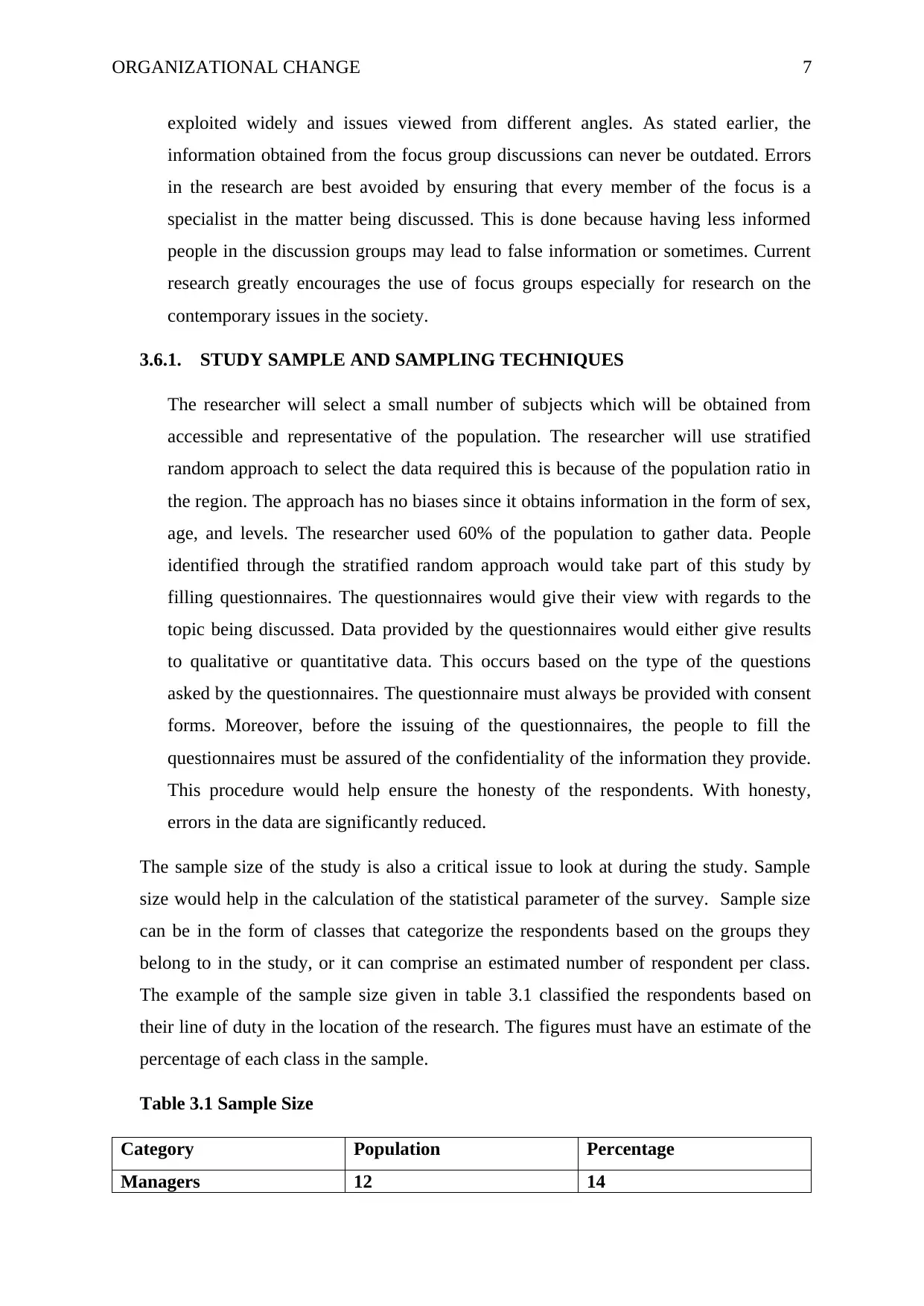
ORGANIZATIONAL CHANGE 7
exploited widely and issues viewed from different angles. As stated earlier, the
information obtained from the focus group discussions can never be outdated. Errors
in the research are best avoided by ensuring that every member of the focus is a
specialist in the matter being discussed. This is done because having less informed
people in the discussion groups may lead to false information or sometimes. Current
research greatly encourages the use of focus groups especially for research on the
contemporary issues in the society.
3.6.1. STUDY SAMPLE AND SAMPLING TECHNIQUES
The researcher will select a small number of subjects which will be obtained from
accessible and representative of the population. The researcher will use stratified
random approach to select the data required this is because of the population ratio in
the region. The approach has no biases since it obtains information in the form of sex,
age, and levels. The researcher used 60% of the population to gather data. People
identified through the stratified random approach would take part of this study by
filling questionnaires. The questionnaires would give their view with regards to the
topic being discussed. Data provided by the questionnaires would either give results
to qualitative or quantitative data. This occurs based on the type of the questions
asked by the questionnaires. The questionnaire must always be provided with consent
forms. Moreover, before the issuing of the questionnaires, the people to fill the
questionnaires must be assured of the confidentiality of the information they provide.
This procedure would help ensure the honesty of the respondents. With honesty,
errors in the data are significantly reduced.
The sample size of the study is also a critical issue to look at during the study. Sample
size would help in the calculation of the statistical parameter of the survey. Sample size
can be in the form of classes that categorize the respondents based on the groups they
belong to in the study, or it can comprise an estimated number of respondent per class.
The example of the sample size given in table 3.1 classified the respondents based on
their line of duty in the location of the research. The figures must have an estimate of the
percentage of each class in the sample.
Table 3.1 Sample Size
Category Population Percentage
Managers 12 14
exploited widely and issues viewed from different angles. As stated earlier, the
information obtained from the focus group discussions can never be outdated. Errors
in the research are best avoided by ensuring that every member of the focus is a
specialist in the matter being discussed. This is done because having less informed
people in the discussion groups may lead to false information or sometimes. Current
research greatly encourages the use of focus groups especially for research on the
contemporary issues in the society.
3.6.1. STUDY SAMPLE AND SAMPLING TECHNIQUES
The researcher will select a small number of subjects which will be obtained from
accessible and representative of the population. The researcher will use stratified
random approach to select the data required this is because of the population ratio in
the region. The approach has no biases since it obtains information in the form of sex,
age, and levels. The researcher used 60% of the population to gather data. People
identified through the stratified random approach would take part of this study by
filling questionnaires. The questionnaires would give their view with regards to the
topic being discussed. Data provided by the questionnaires would either give results
to qualitative or quantitative data. This occurs based on the type of the questions
asked by the questionnaires. The questionnaire must always be provided with consent
forms. Moreover, before the issuing of the questionnaires, the people to fill the
questionnaires must be assured of the confidentiality of the information they provide.
This procedure would help ensure the honesty of the respondents. With honesty,
errors in the data are significantly reduced.
The sample size of the study is also a critical issue to look at during the study. Sample
size would help in the calculation of the statistical parameter of the survey. Sample size
can be in the form of classes that categorize the respondents based on the groups they
belong to in the study, or it can comprise an estimated number of respondent per class.
The example of the sample size given in table 3.1 classified the respondents based on
their line of duty in the location of the research. The figures must have an estimate of the
percentage of each class in the sample.
Table 3.1 Sample Size
Category Population Percentage
Managers 12 14
Paraphrase This Document
Need a fresh take? Get an instant paraphrase of this document with our AI Paraphraser
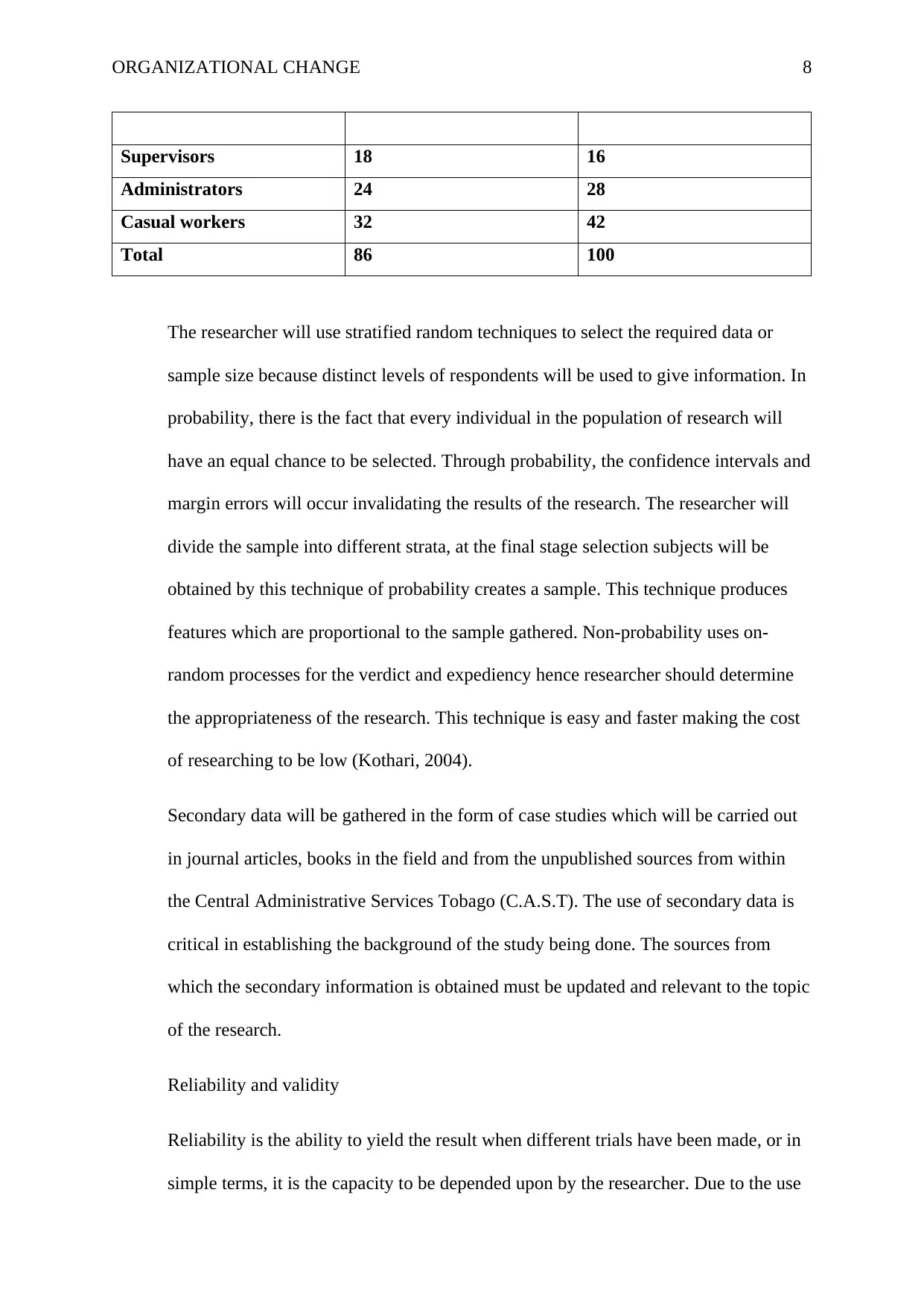
ORGANIZATIONAL CHANGE 8
Supervisors 18 16
Administrators 24 28
Casual workers 32 42
Total 86 100
The researcher will use stratified random techniques to select the required data or
sample size because distinct levels of respondents will be used to give information. In
probability, there is the fact that every individual in the population of research will
have an equal chance to be selected. Through probability, the confidence intervals and
margin errors will occur invalidating the results of the research. The researcher will
divide the sample into different strata, at the final stage selection subjects will be
obtained by this technique of probability creates a sample. This technique produces
features which are proportional to the sample gathered. Non-probability uses on-
random processes for the verdict and expediency hence researcher should determine
the appropriateness of the research. This technique is easy and faster making the cost
of researching to be low (Kothari, 2004).
Secondary data will be gathered in the form of case studies which will be carried out
in journal articles, books in the field and from the unpublished sources from within
the Central Administrative Services Tobago (C.A.S.T). The use of secondary data is
critical in establishing the background of the study being done. The sources from
which the secondary information is obtained must be updated and relevant to the topic
of the research.
Reliability and validity
Reliability is the ability to yield the result when different trials have been made, or in
simple terms, it is the capacity to be depended upon by the researcher. Due to the use
Supervisors 18 16
Administrators 24 28
Casual workers 32 42
Total 86 100
The researcher will use stratified random techniques to select the required data or
sample size because distinct levels of respondents will be used to give information. In
probability, there is the fact that every individual in the population of research will
have an equal chance to be selected. Through probability, the confidence intervals and
margin errors will occur invalidating the results of the research. The researcher will
divide the sample into different strata, at the final stage selection subjects will be
obtained by this technique of probability creates a sample. This technique produces
features which are proportional to the sample gathered. Non-probability uses on-
random processes for the verdict and expediency hence researcher should determine
the appropriateness of the research. This technique is easy and faster making the cost
of researching to be low (Kothari, 2004).
Secondary data will be gathered in the form of case studies which will be carried out
in journal articles, books in the field and from the unpublished sources from within
the Central Administrative Services Tobago (C.A.S.T). The use of secondary data is
critical in establishing the background of the study being done. The sources from
which the secondary information is obtained must be updated and relevant to the topic
of the research.
Reliability and validity
Reliability is the ability to yield the result when different trials have been made, or in
simple terms, it is the capacity to be depended upon by the researcher. Due to the use
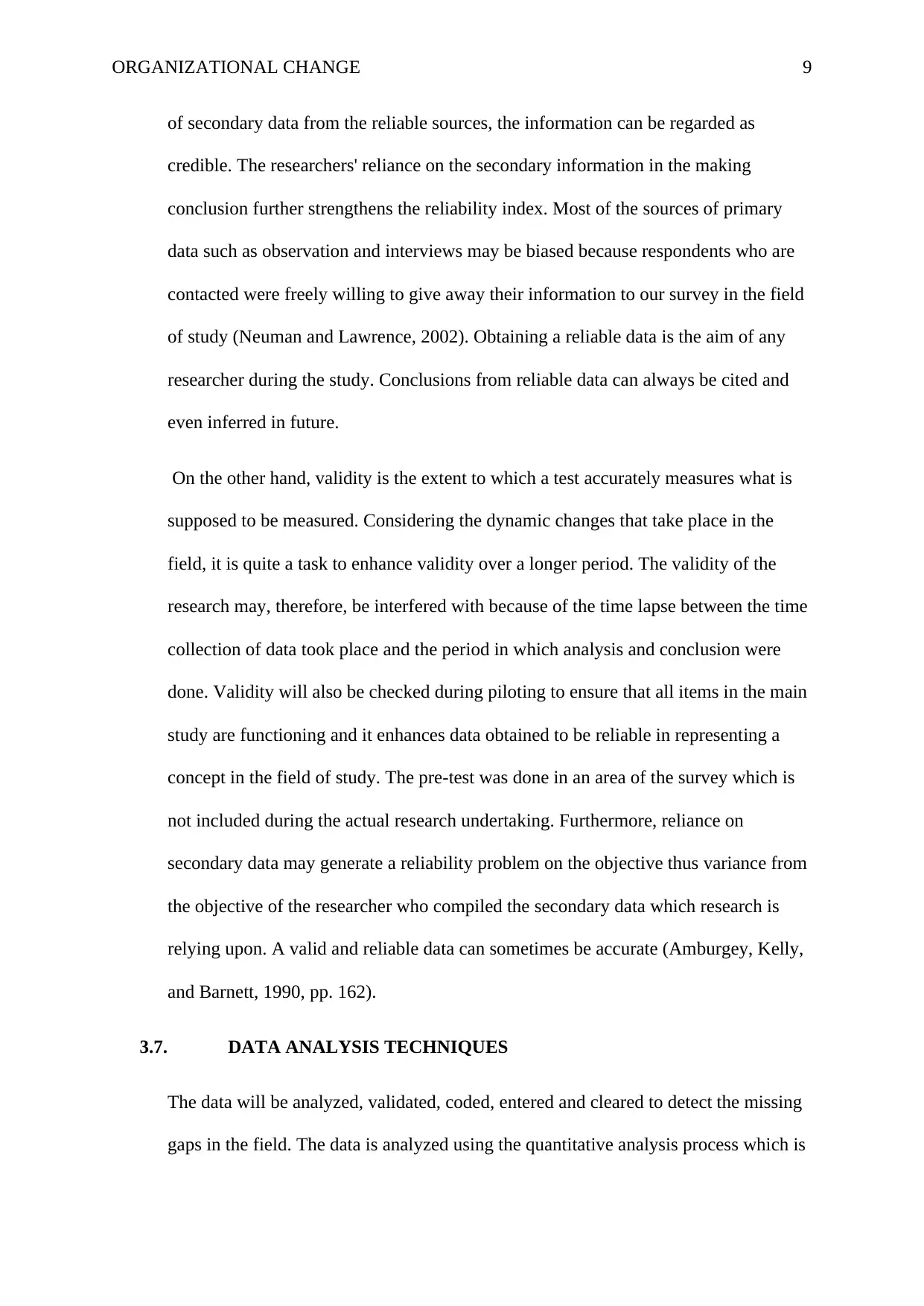
ORGANIZATIONAL CHANGE 9
of secondary data from the reliable sources, the information can be regarded as
credible. The researchers' reliance on the secondary information in the making
conclusion further strengthens the reliability index. Most of the sources of primary
data such as observation and interviews may be biased because respondents who are
contacted were freely willing to give away their information to our survey in the field
of study (Neuman and Lawrence, 2002). Obtaining a reliable data is the aim of any
researcher during the study. Conclusions from reliable data can always be cited and
even inferred in future.
On the other hand, validity is the extent to which a test accurately measures what is
supposed to be measured. Considering the dynamic changes that take place in the
field, it is quite a task to enhance validity over a longer period. The validity of the
research may, therefore, be interfered with because of the time lapse between the time
collection of data took place and the period in which analysis and conclusion were
done. Validity will also be checked during piloting to ensure that all items in the main
study are functioning and it enhances data obtained to be reliable in representing a
concept in the field of study. The pre-test was done in an area of the survey which is
not included during the actual research undertaking. Furthermore, reliance on
secondary data may generate a reliability problem on the objective thus variance from
the objective of the researcher who compiled the secondary data which research is
relying upon. A valid and reliable data can sometimes be accurate (Amburgey, Kelly,
and Barnett, 1990, pp. 162).
3.7. DATA ANALYSIS TECHNIQUES
The data will be analyzed, validated, coded, entered and cleared to detect the missing
gaps in the field. The data is analyzed using the quantitative analysis process which is
of secondary data from the reliable sources, the information can be regarded as
credible. The researchers' reliance on the secondary information in the making
conclusion further strengthens the reliability index. Most of the sources of primary
data such as observation and interviews may be biased because respondents who are
contacted were freely willing to give away their information to our survey in the field
of study (Neuman and Lawrence, 2002). Obtaining a reliable data is the aim of any
researcher during the study. Conclusions from reliable data can always be cited and
even inferred in future.
On the other hand, validity is the extent to which a test accurately measures what is
supposed to be measured. Considering the dynamic changes that take place in the
field, it is quite a task to enhance validity over a longer period. The validity of the
research may, therefore, be interfered with because of the time lapse between the time
collection of data took place and the period in which analysis and conclusion were
done. Validity will also be checked during piloting to ensure that all items in the main
study are functioning and it enhances data obtained to be reliable in representing a
concept in the field of study. The pre-test was done in an area of the survey which is
not included during the actual research undertaking. Furthermore, reliance on
secondary data may generate a reliability problem on the objective thus variance from
the objective of the researcher who compiled the secondary data which research is
relying upon. A valid and reliable data can sometimes be accurate (Amburgey, Kelly,
and Barnett, 1990, pp. 162).
3.7. DATA ANALYSIS TECHNIQUES
The data will be analyzed, validated, coded, entered and cleared to detect the missing
gaps in the field. The data is analyzed using the quantitative analysis process which is
⊘ This is a preview!⊘
Do you want full access?
Subscribe today to unlock all pages.

Trusted by 1+ million students worldwide
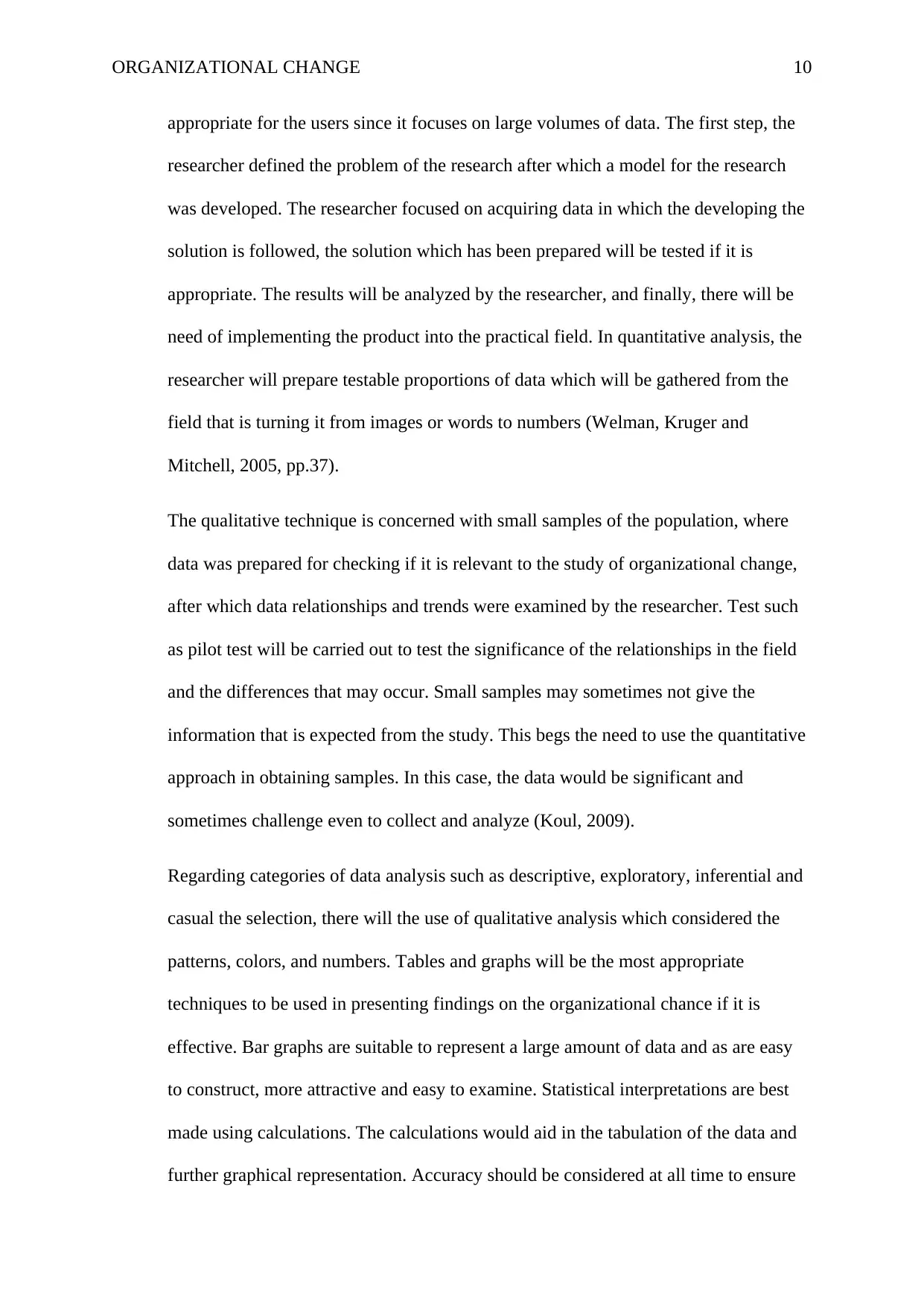
ORGANIZATIONAL CHANGE 10
appropriate for the users since it focuses on large volumes of data. The first step, the
researcher defined the problem of the research after which a model for the research
was developed. The researcher focused on acquiring data in which the developing the
solution is followed, the solution which has been prepared will be tested if it is
appropriate. The results will be analyzed by the researcher, and finally, there will be
need of implementing the product into the practical field. In quantitative analysis, the
researcher will prepare testable proportions of data which will be gathered from the
field that is turning it from images or words to numbers (Welman, Kruger and
Mitchell, 2005, pp.37).
The qualitative technique is concerned with small samples of the population, where
data was prepared for checking if it is relevant to the study of organizational change,
after which data relationships and trends were examined by the researcher. Test such
as pilot test will be carried out to test the significance of the relationships in the field
and the differences that may occur. Small samples may sometimes not give the
information that is expected from the study. This begs the need to use the quantitative
approach in obtaining samples. In this case, the data would be significant and
sometimes challenge even to collect and analyze (Koul, 2009).
Regarding categories of data analysis such as descriptive, exploratory, inferential and
casual the selection, there will the use of qualitative analysis which considered the
patterns, colors, and numbers. Tables and graphs will be the most appropriate
techniques to be used in presenting findings on the organizational chance if it is
effective. Bar graphs are suitable to represent a large amount of data and as are easy
to construct, more attractive and easy to examine. Statistical interpretations are best
made using calculations. The calculations would aid in the tabulation of the data and
further graphical representation. Accuracy should be considered at all time to ensure
appropriate for the users since it focuses on large volumes of data. The first step, the
researcher defined the problem of the research after which a model for the research
was developed. The researcher focused on acquiring data in which the developing the
solution is followed, the solution which has been prepared will be tested if it is
appropriate. The results will be analyzed by the researcher, and finally, there will be
need of implementing the product into the practical field. In quantitative analysis, the
researcher will prepare testable proportions of data which will be gathered from the
field that is turning it from images or words to numbers (Welman, Kruger and
Mitchell, 2005, pp.37).
The qualitative technique is concerned with small samples of the population, where
data was prepared for checking if it is relevant to the study of organizational change,
after which data relationships and trends were examined by the researcher. Test such
as pilot test will be carried out to test the significance of the relationships in the field
and the differences that may occur. Small samples may sometimes not give the
information that is expected from the study. This begs the need to use the quantitative
approach in obtaining samples. In this case, the data would be significant and
sometimes challenge even to collect and analyze (Koul, 2009).
Regarding categories of data analysis such as descriptive, exploratory, inferential and
casual the selection, there will the use of qualitative analysis which considered the
patterns, colors, and numbers. Tables and graphs will be the most appropriate
techniques to be used in presenting findings on the organizational chance if it is
effective. Bar graphs are suitable to represent a large amount of data and as are easy
to construct, more attractive and easy to examine. Statistical interpretations are best
made using calculations. The calculations would aid in the tabulation of the data and
further graphical representation. Accuracy should be considered at all time to ensure
Paraphrase This Document
Need a fresh take? Get an instant paraphrase of this document with our AI Paraphraser
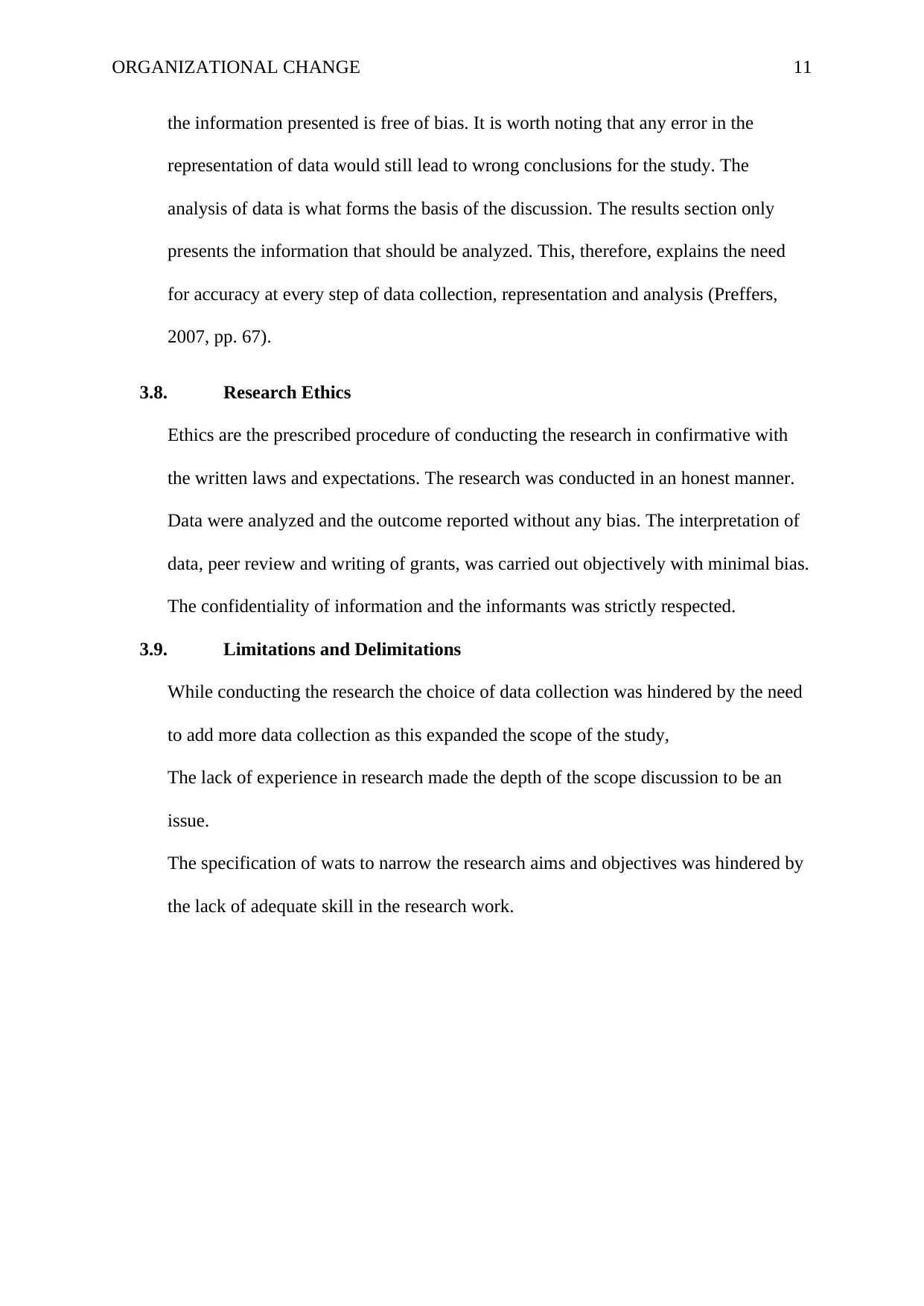
ORGANIZATIONAL CHANGE 11
the information presented is free of bias. It is worth noting that any error in the
representation of data would still lead to wrong conclusions for the study. The
analysis of data is what forms the basis of the discussion. The results section only
presents the information that should be analyzed. This, therefore, explains the need
for accuracy at every step of data collection, representation and analysis (Preffers,
2007, pp. 67).
3.8. Research Ethics
Ethics are the prescribed procedure of conducting the research in confirmative with
the written laws and expectations. The research was conducted in an honest manner.
Data were analyzed and the outcome reported without any bias. The interpretation of
data, peer review and writing of grants, was carried out objectively with minimal bias.
The confidentiality of information and the informants was strictly respected.
3.9. Limitations and Delimitations
While conducting the research the choice of data collection was hindered by the need
to add more data collection as this expanded the scope of the study,
The lack of experience in research made the depth of the scope discussion to be an
issue.
The specification of wats to narrow the research aims and objectives was hindered by
the lack of adequate skill in the research work.
the information presented is free of bias. It is worth noting that any error in the
representation of data would still lead to wrong conclusions for the study. The
analysis of data is what forms the basis of the discussion. The results section only
presents the information that should be analyzed. This, therefore, explains the need
for accuracy at every step of data collection, representation and analysis (Preffers,
2007, pp. 67).
3.8. Research Ethics
Ethics are the prescribed procedure of conducting the research in confirmative with
the written laws and expectations. The research was conducted in an honest manner.
Data were analyzed and the outcome reported without any bias. The interpretation of
data, peer review and writing of grants, was carried out objectively with minimal bias.
The confidentiality of information and the informants was strictly respected.
3.9. Limitations and Delimitations
While conducting the research the choice of data collection was hindered by the need
to add more data collection as this expanded the scope of the study,
The lack of experience in research made the depth of the scope discussion to be an
issue.
The specification of wats to narrow the research aims and objectives was hindered by
the lack of adequate skill in the research work.
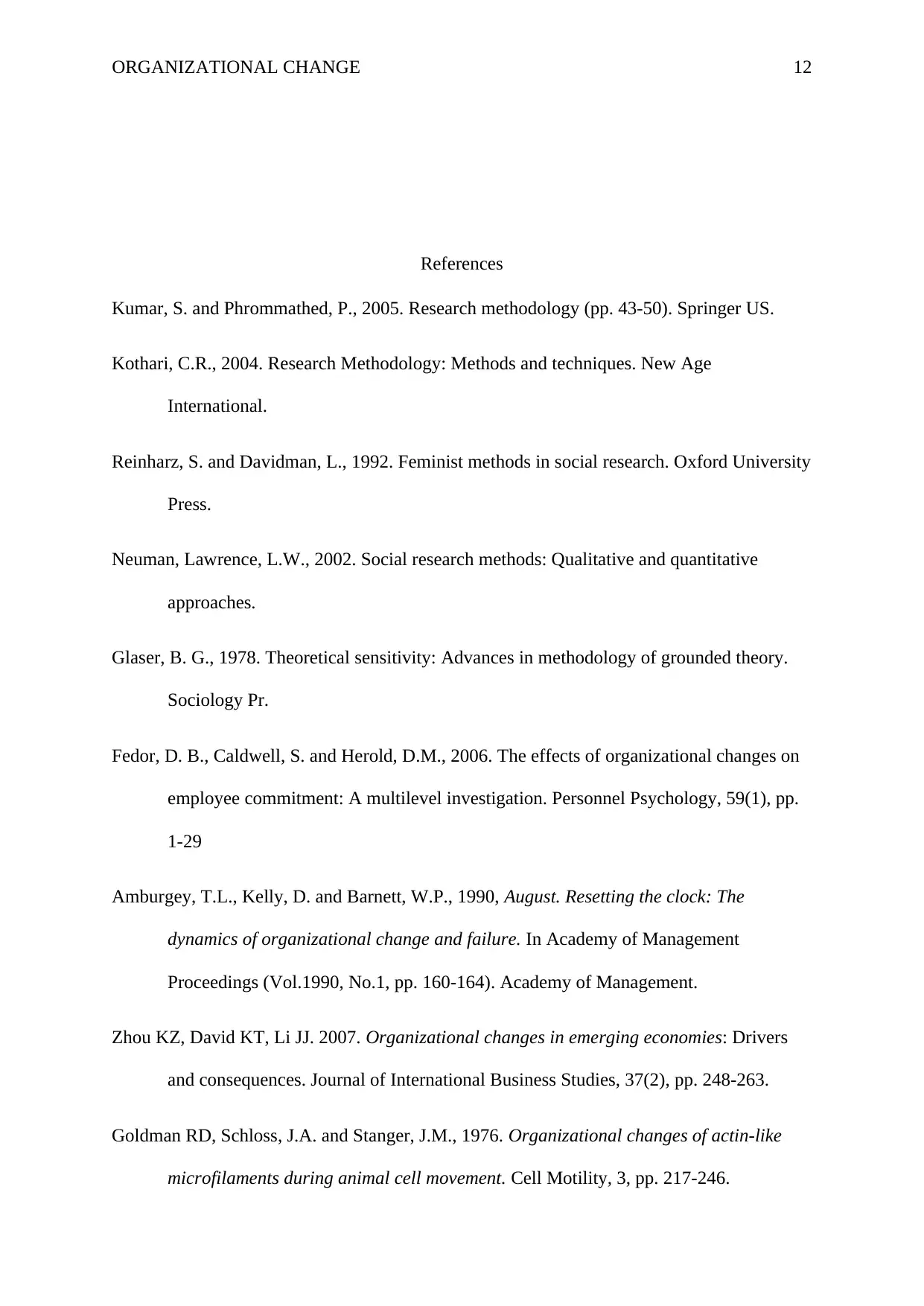
ORGANIZATIONAL CHANGE 12
References
Kumar, S. and Phrommathed, P., 2005. Research methodology (pp. 43-50). Springer US.
Kothari, C.R., 2004. Research Methodology: Methods and techniques. New Age
International.
Reinharz, S. and Davidman, L., 1992. Feminist methods in social research. Oxford University
Press.
Neuman, Lawrence, L.W., 2002. Social research methods: Qualitative and quantitative
approaches.
Glaser, B. G., 1978. Theoretical sensitivity: Advances in methodology of grounded theory.
Sociology Pr.
Fedor, D. B., Caldwell, S. and Herold, D.M., 2006. The effects of organizational changes on
employee commitment: A multilevel investigation. Personnel Psychology, 59(1), pp.
1-29
Amburgey, T.L., Kelly, D. and Barnett, W.P., 1990, August. Resetting the clock: The
dynamics of organizational change and failure. In Academy of Management
Proceedings (Vol.1990, No.1, pp. 160-164). Academy of Management.
Zhou KZ, David KT, Li JJ. 2007. Organizational changes in emerging economies: Drivers
and consequences. Journal of International Business Studies, 37(2), pp. 248-263.
Goldman RD, Schloss, J.A. and Stanger, J.M., 1976. Organizational changes of actin-like
microfilaments during animal cell movement. Cell Motility, 3, pp. 217-246.
References
Kumar, S. and Phrommathed, P., 2005. Research methodology (pp. 43-50). Springer US.
Kothari, C.R., 2004. Research Methodology: Methods and techniques. New Age
International.
Reinharz, S. and Davidman, L., 1992. Feminist methods in social research. Oxford University
Press.
Neuman, Lawrence, L.W., 2002. Social research methods: Qualitative and quantitative
approaches.
Glaser, B. G., 1978. Theoretical sensitivity: Advances in methodology of grounded theory.
Sociology Pr.
Fedor, D. B., Caldwell, S. and Herold, D.M., 2006. The effects of organizational changes on
employee commitment: A multilevel investigation. Personnel Psychology, 59(1), pp.
1-29
Amburgey, T.L., Kelly, D. and Barnett, W.P., 1990, August. Resetting the clock: The
dynamics of organizational change and failure. In Academy of Management
Proceedings (Vol.1990, No.1, pp. 160-164). Academy of Management.
Zhou KZ, David KT, Li JJ. 2007. Organizational changes in emerging economies: Drivers
and consequences. Journal of International Business Studies, 37(2), pp. 248-263.
Goldman RD, Schloss, J.A. and Stanger, J.M., 1976. Organizational changes of actin-like
microfilaments during animal cell movement. Cell Motility, 3, pp. 217-246.
⊘ This is a preview!⊘
Do you want full access?
Subscribe today to unlock all pages.

Trusted by 1+ million students worldwide
1 out of 13
Related Documents
Your All-in-One AI-Powered Toolkit for Academic Success.
+13062052269
info@desklib.com
Available 24*7 on WhatsApp / Email
![[object Object]](/_next/static/media/star-bottom.7253800d.svg)
Unlock your academic potential
Copyright © 2020–2025 A2Z Services. All Rights Reserved. Developed and managed by ZUCOL.





